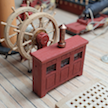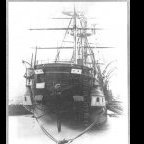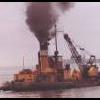MORE HANDBOOKS ARE ON THEIR WAY! We will let you know when they get here.
×
-
Posts
629 -
Joined
-
Last visited
Reputation Activity
-
 kruginmi reacted to Keith Black in Jylland by kruginmi - Billings Boats - 1:100
kruginmi reacted to Keith Black in Jylland by kruginmi - Billings Boats - 1:100
Very nice, Mark. Lovely work.
-
 kruginmi got a reaction from GrandpaPhil in Jylland by kruginmi - Billings Boats - 1:100
kruginmi got a reaction from GrandpaPhil in Jylland by kruginmi - Billings Boats - 1:100
After slicing the tip of my thumb off (not even hobby related) back to getting the chain plates on so I can start the second planking.
For strength I like to key them in. A little more work but I think worth it. First step was to sand the facing edge flush against the hull side. Important step is to get all the bevels correct so chain plate parallel to waterline and not perpendicular to hull.
I can still work the mating surface for an even better fit but keep remembering there is still a veneer planking which will cover the entire joint.
Mark
-
 kruginmi got a reaction from robdurant in Jylland by kruginmi - Billings Boats - 1:100
kruginmi got a reaction from robdurant in Jylland by kruginmi - Billings Boats - 1:100
After slicing the tip of my thumb off (not even hobby related) back to getting the chain plates on so I can start the second planking.
For strength I like to key them in. A little more work but I think worth it. First step was to sand the facing edge flush against the hull side. Important step is to get all the bevels correct so chain plate parallel to waterline and not perpendicular to hull.
I can still work the mating surface for an even better fit but keep remembering there is still a veneer planking which will cover the entire joint.
Mark
-
 kruginmi got a reaction from GrandpaPhil in Jylland by kruginmi - Billings Boats - 1:100
kruginmi got a reaction from GrandpaPhil in Jylland by kruginmi - Billings Boats - 1:100
Next step was to mark the copper line. Put the ship back into the building slip and (gently) ran a fixed pencil line at the appropriate level. The copper section will be replicated using just paint. The upper section will be planked with veneer.
I then marked ribs at 5 foot scale intervals. This will allow me to align the plank ends up. Probably going with 15 foot scale plank lengths.
To finish everything off I marked off the chain plates. These will be built next and keyed into the hull for strength. One of the bonuses of double planking is that the planking can effectively cover up any joins.
The hawse hole rings are currently press fit and can be removed easily. Just having fun.
Mark
-
 kruginmi got a reaction from Keith Black in Jylland by kruginmi - Billings Boats - 1:100
kruginmi got a reaction from Keith Black in Jylland by kruginmi - Billings Boats - 1:100
Next step was to mark the copper line. Put the ship back into the building slip and (gently) ran a fixed pencil line at the appropriate level. The copper section will be replicated using just paint. The upper section will be planked with veneer.
I then marked ribs at 5 foot scale intervals. This will allow me to align the plank ends up. Probably going with 15 foot scale plank lengths.
To finish everything off I marked off the chain plates. These will be built next and keyed into the hull for strength. One of the bonuses of double planking is that the planking can effectively cover up any joins.
The hawse hole rings are currently press fit and can be removed easily. Just having fun.
Mark
-
 kruginmi got a reaction from GrandpaPhil in Jylland by kruginmi - Billings Boats - 1:100
kruginmi got a reaction from GrandpaPhil in Jylland by kruginmi - Billings Boats - 1:100
Catheads and braces, along with hawse holes in place.
Now to define the dividing line to the copper plates. Additionally will pencil in faux bulkheads every 5 feet (every 5/8 inches) from this line to top of bulwark. This will allow me to stagger the joints of the 2nd planking. Still need to figure out the width of the planks themselves. Looks like 4 rows per gunport is an estimate. Question is, do I do 2 rows to make it look better at scale.
Mark
p.s. Need to identify the locations of the vertical posts. Might be better to add prior to 2nd layer planking.
-
 kruginmi got a reaction from GrandpaPhil in Jylland by kruginmi - Billings Boats - 1:100
kruginmi got a reaction from GrandpaPhil in Jylland by kruginmi - Billings Boats - 1:100
WIth Spring comes many requirements on your time.
I worked out the catheads laminating 10 pieces of wood. 7/32 of an inch. Still need to create the sheaves (will use plastic rod). I have one other one as a prototype to determine the angle and length to the hull. This will go through the outer bulwark and secure to the inner for strength.
-
 kruginmi got a reaction from GrandpaPhil in Jylland by kruginmi - Billings Boats - 1:100
kruginmi got a reaction from GrandpaPhil in Jylland by kruginmi - Billings Boats - 1:100
Question: New area for me - looking to paint below the waterline and veneer plank above. What are the recommendations for sealer and/or primer? Lots of choices out there. Anyone give me lessons learned or solid guidance?
Enough with the full length hull shots already! Well, how about one more.
Filled and sanded the port side (for clarity, the pic shows it not sanded LOL).
While I had the filler out I looked at the bottom of the keel as well as stem. I had laminated basswood over the original and that was exactly how it looked, so masked off and wood filled that area also. Prime goal was to clean up the head on shot.
Now need to get the rudder hole drilled out and define the catheads.
Mark
-
 kruginmi got a reaction from GrandpaPhil in Jylland by kruginmi - Billings Boats - 1:100
kruginmi got a reaction from GrandpaPhil in Jylland by kruginmi - Billings Boats - 1:100
Wax on - Wax off.....
Got the Starboard side slathered up with wood filler (not Elmers Glue-All) and then after a day or two, sanded most of it off. Hull feels silky smooth. Maybe a couple of touch up points but will probably seal and prime first for better visibility. That filler sure is a fine talcum powderish dust when sanding. Good ventilation is a must. I stood in the middle of my front yard with a good breeze going.
Stern side up next then position the catheads / brace finally the fore and aft deck house bulkheads.
Mark
-
 kruginmi got a reaction from Keith Black in Jylland by kruginmi - Billings Boats - 1:100
kruginmi got a reaction from Keith Black in Jylland by kruginmi - Billings Boats - 1:100
WIth Spring comes many requirements on your time.
I worked out the catheads laminating 10 pieces of wood. 7/32 of an inch. Still need to create the sheaves (will use plastic rod). I have one other one as a prototype to determine the angle and length to the hull. This will go through the outer bulwark and secure to the inner for strength.
-
 kruginmi got a reaction from clearway in Jylland by kruginmi - Billings Boats - 1:100
kruginmi got a reaction from clearway in Jylland by kruginmi - Billings Boats - 1:100
I should mention I do plastic vacuform planes on the side. I have an airbrush and primarily use acrylics for this. Just scratching my head for what is best for wood as well as handling after the paint is complete.
Thinking a non-acrylic primer with the patina added with acrylics. This would be followed by a non-acrylic varnish. One concern is that the veneer needs to be glued over the primer. I would prefer not using super glue.
Mark
-
 kruginmi got a reaction from Keith Black in Jylland by kruginmi - Billings Boats - 1:100
kruginmi got a reaction from Keith Black in Jylland by kruginmi - Billings Boats - 1:100
I should mention I do plastic vacuform planes on the side. I have an airbrush and primarily use acrylics for this. Just scratching my head for what is best for wood as well as handling after the paint is complete.
Thinking a non-acrylic primer with the patina added with acrylics. This would be followed by a non-acrylic varnish. One concern is that the veneer needs to be glued over the primer. I would prefer not using super glue.
Mark
-
 kruginmi got a reaction from Keith Black in Jylland by kruginmi - Billings Boats - 1:100
kruginmi got a reaction from Keith Black in Jylland by kruginmi - Billings Boats - 1:100
Question: New area for me - looking to paint below the waterline and veneer plank above. What are the recommendations for sealer and/or primer? Lots of choices out there. Anyone give me lessons learned or solid guidance?
Enough with the full length hull shots already! Well, how about one more.
Filled and sanded the port side (for clarity, the pic shows it not sanded LOL).
While I had the filler out I looked at the bottom of the keel as well as stem. I had laminated basswood over the original and that was exactly how it looked, so masked off and wood filled that area also. Prime goal was to clean up the head on shot.
Now need to get the rudder hole drilled out and define the catheads.
Mark
-
 kruginmi got a reaction from robdurant in Jylland by kruginmi - Billings Boats - 1:100
kruginmi got a reaction from robdurant in Jylland by kruginmi - Billings Boats - 1:100
Wax on - Wax off.....
Got the Starboard side slathered up with wood filler (not Elmers Glue-All) and then after a day or two, sanded most of it off. Hull feels silky smooth. Maybe a couple of touch up points but will probably seal and prime first for better visibility. That filler sure is a fine talcum powderish dust when sanding. Good ventilation is a must. I stood in the middle of my front yard with a good breeze going.
Stern side up next then position the catheads / brace finally the fore and aft deck house bulkheads.
Mark
-
 kruginmi got a reaction from Keith Black in Jylland by kruginmi - Billings Boats - 1:100
kruginmi got a reaction from Keith Black in Jylland by kruginmi - Billings Boats - 1:100
Wax on - Wax off.....
Got the Starboard side slathered up with wood filler (not Elmers Glue-All) and then after a day or two, sanded most of it off. Hull feels silky smooth. Maybe a couple of touch up points but will probably seal and prime first for better visibility. That filler sure is a fine talcum powderish dust when sanding. Good ventilation is a must. I stood in the middle of my front yard with a good breeze going.
Stern side up next then position the catheads / brace finally the fore and aft deck house bulkheads.
Mark
-
 kruginmi got a reaction from LeoM in Jylland by kruginmi - Billings Boats - 1:100
kruginmi got a reaction from LeoM in Jylland by kruginmi - Billings Boats - 1:100
Well, got those stern blocks (2 each side) affixed and shaped. A large file for the bulk, then down to sandpaper for tuning. Probably still some more subtle shaping left to do.
With that all the stealers / shaped fillers / blocks are all attached. Now for sanding and more sanding prior to applying a sealer than primer. Above the waterline will be veneer planked.
Funny story: looking at the pic of the port side, rear gun port. Yah, never finished that. Cutting it out won't be that bad, it is just adding the backing plate would have been so much easier reaching in the hull. I have to laugh.
Mark
-
 kruginmi got a reaction from GrandpaPhil in Jylland by kruginmi - Billings Boats - 1:100
kruginmi got a reaction from GrandpaPhil in Jylland by kruginmi - Billings Boats - 1:100
Well, got those stern blocks (2 each side) affixed and shaped. A large file for the bulk, then down to sandpaper for tuning. Probably still some more subtle shaping left to do.
With that all the stealers / shaped fillers / blocks are all attached. Now for sanding and more sanding prior to applying a sealer than primer. Above the waterline will be veneer planked.
Funny story: looking at the pic of the port side, rear gun port. Yah, never finished that. Cutting it out won't be that bad, it is just adding the backing plate would have been so much easier reaching in the hull. I have to laugh.
Mark
-
 kruginmi got a reaction from GrandpaPhil in Jylland by kruginmi - Billings Boats - 1:100
kruginmi got a reaction from GrandpaPhil in Jylland by kruginmi - Billings Boats - 1:100
Anders: In my book search I have found (and am able to procure) this book:
Not the cheapest but I will do it if it is worthwhile. Are you familiar with it?
It is not by the author you had given but still not finding a copy that I have the ability to get.
Mark
-
 kruginmi got a reaction from GrandpaPhil in Jylland by kruginmi - Billings Boats - 1:100
kruginmi got a reaction from GrandpaPhil in Jylland by kruginmi - Billings Boats - 1:100
I hit a bit of a milestone today. Still have a couple of gaps to fill and the stern blocks to shape and affix, but the hull has been largely closed up. Below the waterline will be a smooth surface, above will be a 2nd planking with veneer. Lots of sanding but it is good to have a rock solid hull in your grasp.
-
 kruginmi got a reaction from GrandpaPhil in Jylland by kruginmi - Billings Boats - 1:100
kruginmi got a reaction from GrandpaPhil in Jylland by kruginmi - Billings Boats - 1:100
Alright, back in operation. Finished up all the bulwarks. This took some time but happy with the result. Again, curved exterior to match the tumblehome but interior perpendicular to deck. 5/32" exposure at top, variable (5/32" to 9/32") at base. Access port towards midships not cut out at this time for strength of total bulwark as I plank the bottom and have the ship inverted occasionally.
The caprail is a plastic u-channel piece that will be glued on later.
Finally getting back to the business at hand - closing up the hull.
Temperatures are sure warming up out there but still pressing on to start sanding / filling / sanding the hull.
Mark
-
 kruginmi got a reaction from GrandpaPhil in Jylland by kruginmi - Billings Boats - 1:100
kruginmi got a reaction from GrandpaPhil in Jylland by kruginmi - Billings Boats - 1:100
Well this takes some time, but the end result is pretty nice. This is the stbd forward section. If you look closely you see the change from 1/16" inner thickness top to bottom at the forward end, to double that at the far end at the deck level only.
I still need to cut out the external gun port, put on the inner skin, then cut the internal four gun port openings.
Going on a family holiday so I will check in from afar for the next bit of time.
Mark
-
 kruginmi got a reaction from GrandpaPhil in Jylland by kruginmi - Billings Boats - 1:100
kruginmi got a reaction from GrandpaPhil in Jylland by kruginmi - Billings Boats - 1:100
Just tried out the 5/32" wide extruded plastic C channel. Fits like a glove.
That will upgrade the look by quite a bit. Sometimes it is the simple things.
Mark
-
 kruginmi got a reaction from GrandpaPhil in Jylland by kruginmi - Billings Boats - 1:100
kruginmi got a reaction from GrandpaPhil in Jylland by kruginmi - Billings Boats - 1:100
A critical part at this juncture is to make sure the cannon ports are the correct height for the cannons. I needed to compensate for the lack of a deck and attached wheels but everything checked out with the plans. Also the first time I dug a cannon out of the kit and actually looked at them.
Once the framework was done on for the inner bulkhead, the ports needed to be cut out of the outer bulwark. This allowed the inner wall to be glued on and then the gunport hole cut out repeated on the inner. I used a drill to identify the corners, sliced through on the opposite side with a sharp knife, then used a riffler file to fine tune.
This whole process was then repeated on the opposing side bulwark.
I am now half way there! Two more stretches of bulwark each with (again) four gun ports. The interesting wrinkly coming up is that the bulwark flairs to the outside by the fore deck. The middle section of the bulwark will become just a constant 1/16". It takes time but really looks pretty cool. I am happy.
Mark
-
 kruginmi got a reaction from GrandpaPhil in Jylland by kruginmi - Billings Boats - 1:100
kruginmi got a reaction from GrandpaPhil in Jylland by kruginmi - Billings Boats - 1:100
On to the inner bulwark and framing. This is a bit hard to capture on camera given that the outer bulwark has a bit of a tumblehome but the inner bulwark is perpendicular to the deck. This tumblehome also changes so no mass producing of stanchions. This can be seen at the mid deck port.
My calculations showed a target of 5/32" at the cap. Given the 1/16" outer and 1/32" inner, that left 1/16" of stanchion post exposed at the cap.
For the rear, this tumblehome was about 1/8" over the height of the bulwark. Using my Byrnes Saw with sled really helped. I used 3/32" bass as the width of the stanchions. For safety and hold, I used a strip of 3/32" at the proper height. On the edge I cut the proposed angle and tested it in position. Adjusting as necessary until it fit against the outer bulwark well.
The 1/16"spacing was then added at the top of the stanchion, a perpendicular to the base line drawn and the stanchion cut out. Lather, rinse and repeat. This takes some time and I have thrown out a few which just didn't turn out. Find your groove, put some nice classical music on and just do it.
The presence of the 4 gun ports necessitated some additional care. I did create a port spacing template to insure the openings where exact across the entire deck. I still need to add the upper and lower beams for each - as well as cut the openings out in the outer bulwark prior to installing the inner bulwark.
I added 1/16" stringers between the stanchions at both top and bottom for better support of the inner bulwark.
The shame is that once I put on the inner bulwark none of this will be seen (and very little people will understand the work required). Our fate in life.
I can state this significantly strengthens the bulwarks.
Mark
-
 kruginmi got a reaction from GrandpaPhil in Jylland by kruginmi - Billings Boats - 1:100
kruginmi got a reaction from GrandpaPhil in Jylland by kruginmi - Billings Boats - 1:100
How do you plank a ship? Well, the basic answer (and a philosophical one) is by adding one plank at a time.
In this picture the new plank has been soaked in very hot water, put in place and is being allowed to dry in place. Once dry enough I will add glue and affix in much the same way (however with much less stress).
Mark






